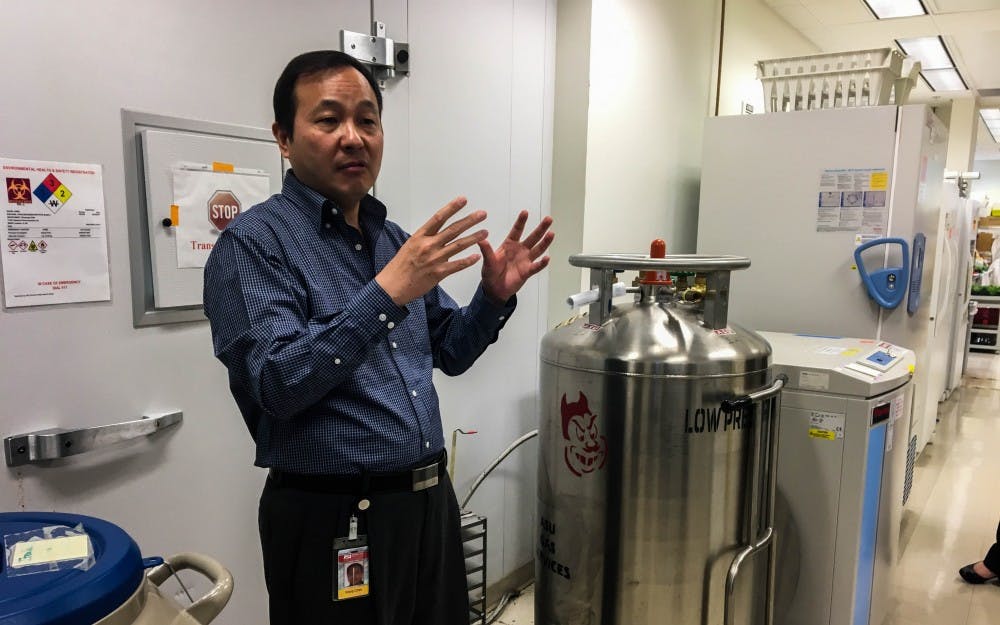ASU's Biodesign Institute is home to over 115 faculty devoted to making breakthroughs in all disciplines of science. The Institute showcased some of its latest advancements in medical technology at their media day on April 20, 2018.
Research ranged from microchips that can detect disease to vaccines that could prevent Ebola.
Tobacco-based miracle drugs
The Biodesign Institute gained some prominence in 2014 for its role in the development of ZMapp, the "superdrug" that miraculously cured doctors stricken with the Ebola virus. But preparations for such an experimental treatment started long before.
ASU assembled a team to develop plant-based vaccines in 2000. They came up with an idea for Ebola treatment in 2005, in case there would be another outbreak of the deadly disease.
The treatment that ASU had a hand in developing came from drugs derived from tobacco plants. It collaborated with Mapp Biopharmaceutical and reported positive results in Ebola prevention in mice in 2011, three years prior to the outbreak in West Africa that captured worldwide attention.
Qiang “Shawn” Chen, a faculty member at the Center for Immunotherapy, Vaccines and Virotherapy at the Institute, explained the advantages of tobacco-grown drugs over traditional methods for producing medicine.
As opposed to using hamster cells to produce drugs, plant-grown drugs are less likely to contain contaminants that could negatively affect humans. They can also be grown faster and stored better, Chen said.
He also used the example of Gaucher's disease for how tobacco has revolutionized drug-making.
"You used to need 200 human placentas to extract one dosage for one person to be injected (with) weekly," Chen said. "For us, we produce in tobacco leaves – one leaf will produce one dose."
Diagnosing diseases with microchips
“We look at a bunch of different aspects of how we can use technology to improve medical outcomes,” said Neal Woodbury, director of the School of Molecular Sciences and faculty at the Biodesign Center for Innovations in Medicine. “One of them is through diagnostics. As you probably know, if you catch a disease early, the probability of being able to do something productive about it is much higher.”
This is particularly true about cancer, Woodbury said. Cancers caught in the earliest stages offer patients a significantly better chance of survival as opposed to Stage 4 or Stage 5 cancers.
Diagnostic tools are therefore important, but can also cause patients harm if they are misdiagnosed.
“It’s really important to come up with very good diagnostics, diagnostics that allow you to make very clinical, good decisions about how to proceed,” Woodbury said.
He explained that the human body has an internal immune system that always looks for signs of illness or trouble in the body. Based on the information that certain cells in the body collect, the immune system decides how to respond.
Using less than a drop of diluted blood placed on a silicon chip, scientists from the Biodesign Institute can read patterns that indicate whether the patient is healthy or sick and what disease is afflicting them. The chips are covered with molecules of peptides, which are proteins that light up when they interact with antibodies in blood.
“That drop of blood is binding to the molecules that are on that chip,” Woodbury said. “If a patient has breast cancer that gives one pattern, if the patient has another disease, that's another (pattern). You have your own pattern as well that's specific to you. If you’re monitoring this over time, we know what your normal pattern is, and then you can see how that pattern changes.”
This technology has been commercialized by HealthTell, one of seven main companies in the Digital Life Alliance which received a $400 million investment to further research the personalization of medicine.
Woodbury said that as the technology advances, the researchers hope it will be available to individuals.
“We want to look at you as a human all the time and understand what you are and what you’re doing, rather than just simply saying one day you’re sick or you’re well,” Woodbury said.
Treatments for Alzheimer’s
Diego Mastroeni, a professor in the School of Life Sciences and a member of the Institute's ASU-Banner Neurodegenerative Disease Research Center, focuses his research on preventing neurodegenerative diseases like Alzheimer's.
"We've been studying Alzheimer's, Parkinson's, ALS and chronic traumatic anencephaly, which is the CTE type of stuff you see in the NFL," Mastroeni said. "This is a really expanding program. We're looking to hire 19 new faculty members in this center, which is really awesome."
Mastroeni said the center's goal is to become one of the best neurodegenerative research centers in the country.
The research takes analysis on tissue cells from brains and uses laser capture technology to differentiate between healthy and sick cells. The cell genome is then sequenced to determine why it is sick.
"We can now have targeted therapies to specific cells," Mastroeni said. "When we use these ubiquitous targets, they can attack all cells, but we don't want it to work on all cells. We want it to work on specific cells."
He envisions a future where these diseases can be prevented with a daily vitamin similar to Vitamin D pills or a nasal spray.
Mastroeni's research was inspired by his grandfather, who suffered from Alzheimer's. He recalled the feelings from the day he admitted his grandfather to a facility.
"When he looked back at me ... he felt like I betrayed him," Mastroeni said. "It was probably the hardest thing I've ever done in my life. From that day on, it was kind of my destiny."
Reach the reporter at sabine.galvis@asu.edu or follow @sabinegalvis on Twitter.
Like The State Press on Facebook and follow @statepress on Twitter.




